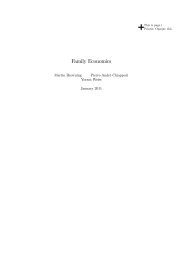Bounded Rationality in Industrial Organization
Bounded Rationality in Industrial Organization
Bounded Rationality in Industrial Organization
You also want an ePaper? Increase the reach of your titles
YUMPU automatically turns print PDFs into web optimized ePapers that Google loves.
John von Neumann and Oskar Morganstern ... Unfortunately, at the time of writ<strong>in</strong>g this<br />
article I had no opportunity of obta<strong>in</strong><strong>in</strong>g a copy of this important book.”<br />
One tends to th<strong>in</strong>k that there was a long era of neoclassical dom<strong>in</strong>ance betweeen the<br />
death of this old literature and the birth of <strong>in</strong>terest <strong>in</strong> post-rationality bounded rationality.<br />
In this light, I f<strong>in</strong>d it noteworthy that less than a decade separates the publication of<br />
Rothschild’s paper and the publication of Simon’s (1955) “A Behavioral Model of Rational<br />
Choice.” Simon is clearly writ<strong>in</strong>g for an audience steeped <strong>in</strong> rationality and sells his bounded<br />
rationality as an enhancement of the prevail<strong>in</strong>g paradigm:<br />
the task is to replace the global rationality of economic man with a k<strong>in</strong>d of<br />
rational behavior that is compatible with the access to <strong>in</strong>formation and the<br />
computational capacities that are actually possessed by organisms.<br />
Simon discusses the various challenges <strong>in</strong>volved <strong>in</strong> optimization. His critiques and visions for<br />
a new framework are compell<strong>in</strong>g. The progress he makes toward this goal is less satisfy<strong>in</strong>g.<br />
He mostly ends up emphasiz<strong>in</strong>g a “satisfic<strong>in</strong>g” model <strong>in</strong> which agents search for actions<br />
until they f<strong>in</strong>d one that achieves a payoff that provides them with at least some aspiration<br />
level.<br />
Cyert and March (1956) is an early application to <strong>in</strong>dustrial organization. In the modern<br />
style, they start by cit<strong>in</strong>g <strong>in</strong>terest<strong>in</strong>g papers from the psychology literature to justify<br />
their assumptions about deviations from profit-maximization. 1 Among the implications of<br />
satisfic<strong>in</strong>g they discuss are that firms are most likely to expand sales when profits are low<br />
and costs high, and that dom<strong>in</strong>ant firms may tend to lose market share over time. The<br />
analytic methodology, of course, is still far from modern: other than one set of diagrams<br />
us<strong>in</strong>g Stigler’s dom<strong>in</strong>ant firm model, the analysis is completely <strong>in</strong>formal. They do present<br />
empirical data related to their hypotheses.<br />
One aspect of this literature that is strik<strong>in</strong>g <strong>in</strong> contrast to the current literature is that<br />
the focus is almost exclusively on firms’ deviations from profit-maximization rather than<br />
on consumer irrationality. Indeed, consumers are rarely mentioned. Their presence is, of<br />
1 For example, the notion that people satisfice is supported by the experiments show<strong>in</strong>g that subject who<br />
are asked to throw darts as close to the center of a target as possible are more accurate when the target is<br />
smaller.<br />
4













